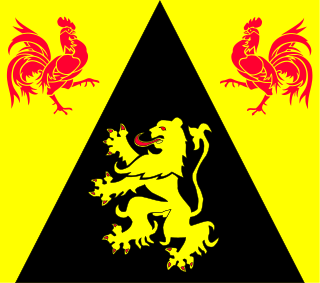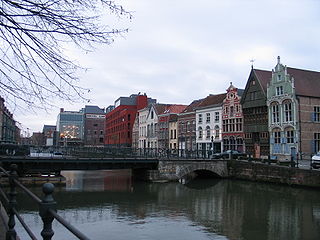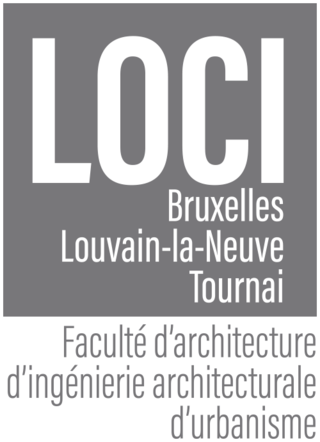
Walloon Brabant is a province located in Belgium's French-speaking region of Wallonia. It borders on the province of Flemish Brabant and the provinces of Liège, Namur and Hainaut. Walloon Brabant's capital and largest city is Wavre.

Ottignies-Louvain-la-Neuve is a city and municipality of Wallonia located in the Belgian province of Walloon Brabant. On January 1, 2006, Ottignies-Louvain-la-Neuve had a total population of 29,521. The total area is 32.96 km² which gives a population density of 896 inhabitants per km².

Louvain-la-Neuve is a planned town in the municipality of Ottignies-Louvain-la-Neuve, Wallonia, Belgium, situated 30 km southeast of Brussels, in the province of Walloon Brabant. The town was built to house the Université catholique de Louvain (UCLouvain) which owns the entire territory of the town; following the linguistic quarrels that took place in Belgium during the 1960s, and Flemish claims of discrimination at the Catholic University of Leuven, the institution was split into the Dutch language Katholieke Universiteit Leuven, which remained in Leuven, and the Université catholique de Louvain.

The Université catholique de Louvain is Belgium's largest French-speaking university. It is located in Louvain-la-Neuve, which was expressly built to house the university, and Brussels, Charleroi, Mons, Tournai and Namur. Since September 2018, the university has used the branding UCLouvain, replacing the acronym UCL, following a merger with Saint-Louis University, Brussels.

The Dyle is a river in central Belgium, left tributary of the Rupel. It is 86 kilometres (53 mi) long. It flows through the Belgian provinces of Walloon Brabant, Flemish Brabant and Antwerp. Its source is in Houtain-le-Val, near Nivelles in Walloon Brabant.

Created in 1971, Louvain-la-Neuve Science Park is the first of its kind in Belgium and is the largest in Wallonia. It covers 231 hectares spread over the area of the municipality of Ottignies-Louvain-la-Neuve and the municipality of Mont-Saint-Guibert.
The Belgian American Educational Foundation (BAEF) is an educational charity. It supports the exchange of university students, scientists and scholars between the United States and Belgium. The foundation fosters the higher education of deserving Belgians and Americans through its exchange-fellowship program. Since 1977, Dr. Emile Boulpaep is the president of the BAEF.

The Cliniques universitaires Saint-Luc is a non-profit academic hospital of the University of Louvain (UCLouvain), located on the university campus of UCLouvain Bruxelles Woluwe in Woluwe-Saint-Lambert, Brussels, Belgium. The hospital opened on 23 August 1976, moving from Leuven to Brussels.
Orchestre symphonique des Étudiants de Louvain-la-Neuve (OSEL) is a Belgian symphony orchestra based in Louvain-la-Neuve, Wallonie, and mainly composed of students from the University of Louvain (UCLouvain).

Ottignies railway station, officially Ottignies, is a railway station in Ottignies-Louvain-la-Neuve, Walloon Brabant, Belgium.
Raymond Martin Marie Ghislain, Baron Lemaire was an art historian and an architectural historian, a leading expert in conservation and professor at the Catholic University of Leuven and later at the KU Leuven and the Université catholique de Louvain in Louvain-la-Neuve.

UCLouvain Bruxelles Woluwe, also known as Louvain-en-Woluwe or Alma, is a campus of the University of Louvain in Brussels, Belgium. The campus, built in the 1970s following the Leuven crisis, houses the Faculties of Medicine and Dentistry, Pharmacy and Biomedical Sciences and of Public Health, the Cliniques universitaires Saint-Luc, the university's main academic hospital, as well as many other institutions of higher education and a vast sports complex.

The Musée L or Musée universitaire de Louvain, French for: Louvain University Museum, is a Belgian university museum of the University of Louvain (UCLouvain) located in Louvain-la-Neuve, Walloon Brabant, Belgium.

UCLouvain Charleroi is a campus of the University of Louvain in Charleroi, Belgium. Consisting of 3 faculties and a series of research centers and institutes, UCLouvain Charleroi consists of the Maison Georges Lemaître, in the center of the city, and a branch in Montignies-sur-Sambre.

The Louvain-la-Neuve Cyclotron is a brutalist architectural complex of the University of Louvain built from 1970 to 1972 in Louvain-la-Neuve, Walloon Brabant, Belgium, notably holding UCLouvain's CYCLONE particle accelerators. It is the first building completed by the university when it moved following the Leuven crisis and was the largest cyclotron in Europe at the time of its construction. The Louvain Cyclotron can also refer to Belgium's first cyclotron built in Louvain (Leuven) in 1947, which was replaced by the Louvain-la-Neuve center.

The Louvain School of Engineering or École polytechnique de Louvain (EPL) is a faculty of the University of Louvain, Belgium, founded in 1864. Known as the Faculty of Applied Sciences prior to 2008, it currently operates on the campuses of Louvain-la-Neuve and UCLouvain Charleroi.

The Faculty of Architecture, Architectural Engineering and Urban Planning, often called LOCI, is the 14th faculty of the University of Louvain, Belgium. It became an independent faculty in 2009, with the merger of three institutes founded between 1867 and 1882, and is active in Brussels (Saint-Gilles), Tournai and Louvain-la-Neuve.

Biéreau Farm is an old Brabantine farm now turned into a cultural and musical centre. It is located in Louvain-la-Neuve, part of the municipality Ottignies-Louvain-la-Neuve, in the province Walloon Brabant in Belgium.
























